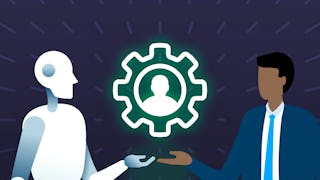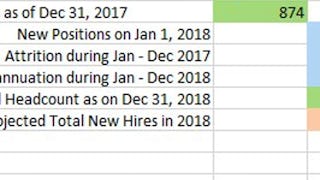With advances in technology and cloud computing, numerous data sources are available to drive organizational success. High-performing HR teams use data as a "decision science" by identifying metrics and data sources that deliver organizational insights. This course focuses on identifying effective data sources, developing meaningful metrics, designing long-term measures, and applying results in support of organizational strategy and tactics.

5 days left: Get a Black Friday boost with $160 off 10,000+ programs. Save now.


(2,108 reviews)
What you'll learn
Apply data-driven decision-making to HR challenges.
Develop and interpret key HR performance metrics.
Leverage analytics for strategic human resource planning.
Utilize data to optimize employee life cycle processes.
Skills you'll gain
- Human Resource Strategy
- Mental Health
- Employee Retention
- Data Analysis
- Training and Development
- Compensation and Benefits
- HR Tech
- Data Presentation
- Employee Relations
- Employee Performance Management
- Talent Recruitment
- Business Analysis
- Performance Metric
- Dashboard
- Data Storytelling
- Business Metrics
- Compensation Strategy
- Employee Engagement
Details to know

Add to your LinkedIn profile
See how employees at top companies are mastering in-demand skills

There are 4 modules in this course
Welcome to the Human Resources Analytics course! We will begin this course by exploring the Human Resources Metric Life Cycle, which will include an analysis of the employee life cycle, HR agility, and the various types of metrics used to measure and drive business outcomes.
What's included
5 videos3 readings4 assignments
In this module, we dive deep into three different types of metrics - staffing, training, and rewards metrics. We explore the various HR functions and the role these functions play in the success of recruiting, hiring, and retaining quality hires. We also look at the key metrics that serve as business drivers for all three types of metrics.
What's included
9 videos2 readings5 assignments
As a continuation of the previous module, we now explore employee relations metrics and the HR organization as a whole. We will also identify strategies to track measures and report on those outcomes.
What's included
5 videos2 readings4 assignments
During this final module, we will explore using the data gathered to effectively create and influence the process of strategic business planning.
What's included
8 videos3 readings4 assignments
Instructor

Offered by
Explore more from Leadership and Management
 Status: Free Trial
Status: Free Trial Status: Free Trial
Status: Free Trial Status: Free Trial
Status: Free TrialUniversity of Pennsylvania
Why people choose Coursera for their career




Learner reviews
2,108 reviews
- 5 stars
69.57%
- 4 stars
21.56%
- 3 stars
5.73%
- 2 stars
1.70%
- 1 star
1.42%
Showing 3 of 2108
Reviewed on Aug 23, 2021
This course has instilled my knowledge acumen with sufficient knowledge support which will lead my confidence in further application in my profession!! Thanks
Reviewed on Feb 11, 2025
Helped me gain a lot of knowledge regarding Human Resourse Metrics. Great articles provided along with personalised coaching, which is great help to revise the topics before taking the assessment.
Reviewed on May 8, 2021
It is a nice course, provides information from very reliable & trusted sources regarding a concept which will continue to assume greater importance in the coming days - HR/People Analytics.

Open new doors with Coursera Plus
Unlimited access to 10,000+ world-class courses, hands-on projects, and job-ready certificate programs - all included in your subscription
Advance your career with an online degree
Earn a degree from world-class universities - 100% online
Join over 3,400 global companies that choose Coursera for Business
Upskill your employees to excel in the digital economy
Frequently asked questions
Human Resources Analytics involves using data-driven insights to improve HR functions and organizational performance. This course will teach you how to apply analytical techniques to HR data to make strategic decisions.
HR analytics helps identify trends in employee performance, engagement, and retention, enabling organizations to optimize human resource strategy, reduce costs, and enhance overall business intelligence.
To access the course materials, assignments and to earn a Certificate, you will need to purchase the Certificate experience when you enroll in a course. You can try a Free Trial instead, or apply for Financial Aid. The course may offer 'Full Course, No Certificate' instead. This option lets you see all course materials, submit required assessments, and get a final grade. This also means that you will not be able to purchase a Certificate experience.
More questions
Financial aid available,
¹ Some assignments in this course are AI-graded. For these assignments, your data will be used in accordance with Coursera's Privacy Notice.


